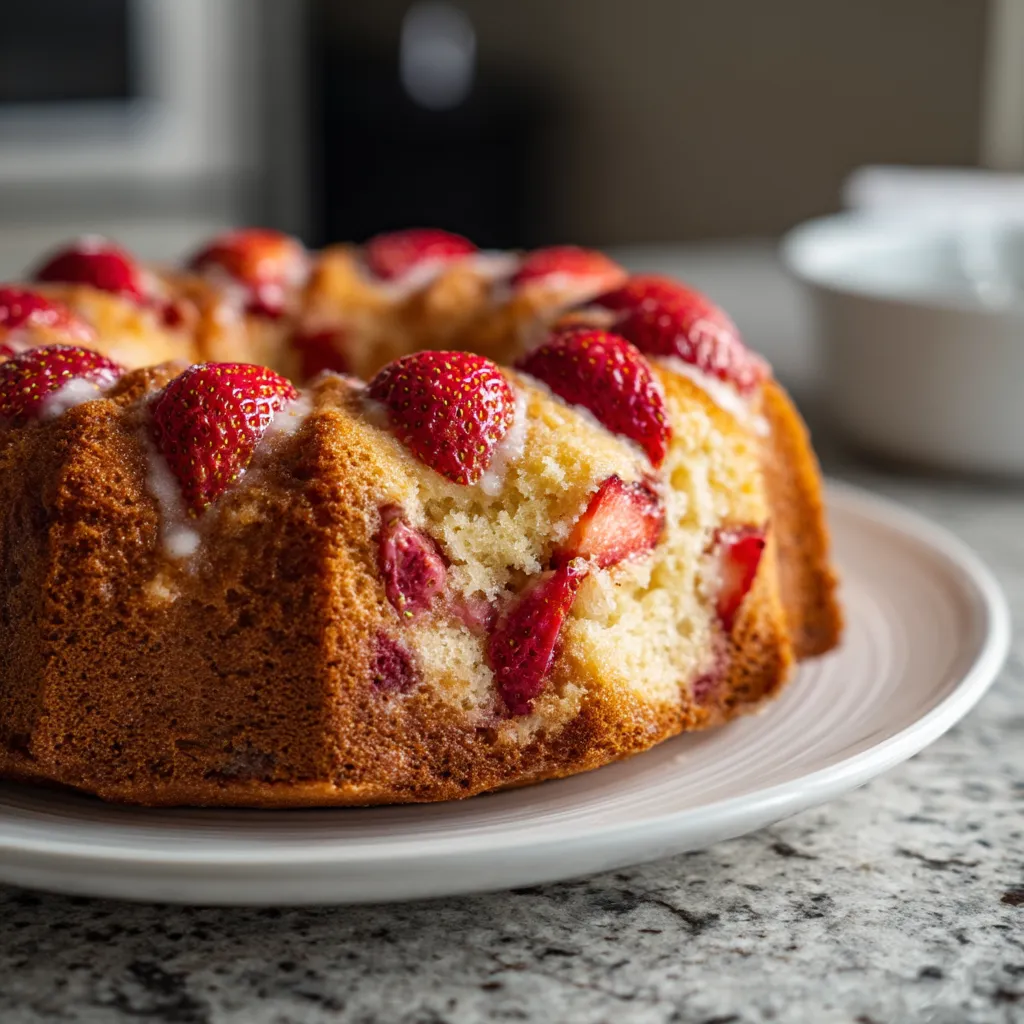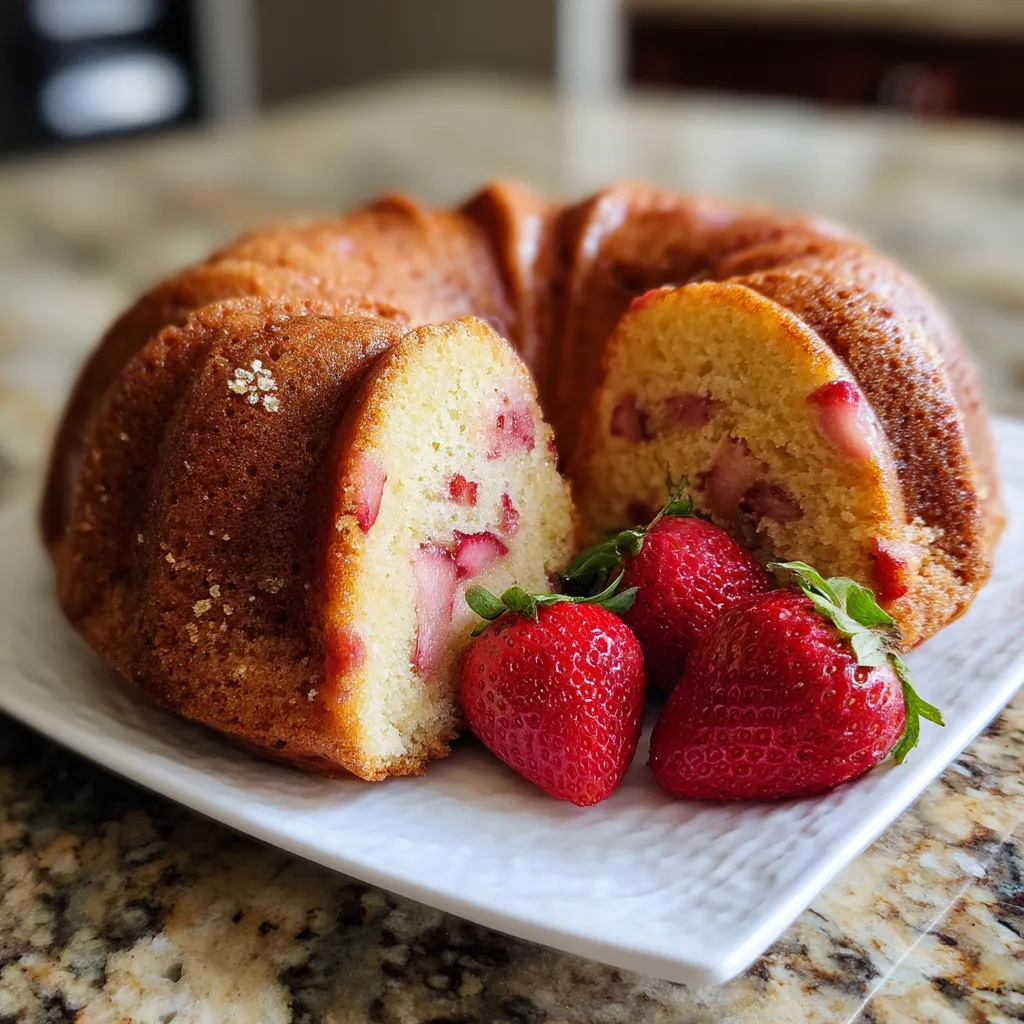 Save to Pinterest
Save to Pinterest This strawberry buttermilk pound cake transforms simple ingredients into a show-stopping dessert that balances rich buttery flavors with bright, juicy strawberries. The secret lies in the buttermilk, which creates an incredibly tender crumb while adding a subtle tanginess that complements the sweet berries perfectly.
I first made this cake for my sister's birthday when fresh strawberries were at their peak. The look on her face when she took that first bite convinced me this recipe needed to become part of our family tradition.
Ingredients
- 2 ½ cups all-purpose flour: carefully measured for the perfect structure
- 1 teaspoon baking powder: provides just the right amount of lift
- ½ teaspoon baking soda: works with buttermilk for tenderness
- ½ teaspoon salt: enhances all flavors and balances sweetness
- 1 cup unsalted butter: room temperature is crucial for proper creaming
- 2 cups granulated sugar: creates that classic pound cake sweetness
- 4 large eggs: at room temperature for better incorporation
- 1 tablespoon vanilla extract: use pure extract for the best flavor
- 1 cup buttermilk: full fat provides the most moisture and flavor
- 1 ½ cups fresh strawberries: choose ripe but firm berries for best results
- 2 tablespoons all-purpose flour: for coating berries prevents sinking
Step-by-Step Instructions
- Prepare Your Equipment:
- Preheat your oven to 325°F and thoroughly grease and flour your Bundt pan. Be meticulous about covering every crevice to ensure easy release later. This step is absolutely critical to prevent sticking.
- Mix Dry Ingredients:
- Whisk flour, baking powder, baking soda, and salt in a medium bowl until completely combined. This even distribution ensures consistent leavening throughout the cake. Take your time here as proper mixing now prevents flour pockets later.
- Cream Butter and Sugar:
- Beat butter and sugar for a full 3 to 5 minutes until the mixture is noticeably lighter in both color and texture. This incorporates air which is essential for a proper rise and light texture. The mixture should look almost fluffy.
- Add Eggs and Vanilla:
- Add eggs one at a time, beating for about 30 seconds after each addition. This gradual incorporation prevents curdling and ensures a silky smooth batter. Add the vanilla and beat until just combined.
- Alternate Dry Ingredients and Buttermilk:
- Add the flour mixture in three parts, alternating with two additions of buttermilk, beginning and ending with flour. Mix gently after each addition until just incorporated. This method prevents overmixing and yields a tender cake.
- Prepare and Fold in Strawberries:
- Toss diced strawberries with flour until each piece is lightly coated. This prevents them from sinking during baking. Use a rubber spatula to gently fold them into the batter with just a few strokes to maintain even distribution.
- Bake to Perfection:
- Pour the batter into your prepared pan and smooth the top. Bake for 60 to 70 minutes, rotating the pan halfway through for even baking. The cake is done when a toothpick inserted in the center comes out clean or with just a few moist crumbs.
- Cool and Serve:
- Allow the cake to cool in the pan for exactly 10 minutes before turning out onto a wire rack. This timing is crucial too little and the cake may break, too much and it might stick. Cool completely before slicing or adding optional glaze.
 Save to Pinterest
Save to Pinterest My grandmother always said the secret to this cake was patience during the creaming step. She would count to 300 slowly while beating the butter and sugar, claiming it was this dedication that made her cakes legendary in our family.
Storing Your Pound Cake
This strawberry pound cake stays remarkably fresh when stored properly. After cooling completely, wrap it tightly in plastic wrap or place in an airtight container. It will remain delicious at room temperature for up to 3 days. For longer storage, refrigerate for up to a week, though the texture is best when brought back to room temperature before serving. You can also freeze individual slices wrapped in plastic and foil for up to 3 months the buttermilk in the recipe helps maintain moisture even after thawing.
Perfect Seasonal Variations
While fresh strawberries create the classic version of this cake, the recipe adapts beautifully to other seasonal fruits. In late summer, try replacing strawberries with the same amount of blueberries or blackberries. For fall, diced apples tossed with cinnamon make a cozy variation. Winter holidays call for cranberries with orange zest. The buttermilk base remains constant, providing that signature tang and moisture regardless of which fruit you choose.
Serving Suggestions
Transform this cake from everyday treat to elegant dessert with thoughtful presentation. For brunch or afternoon tea, serve plain slices with freshly whipped cream on the side. For dinner parties, warm individual slices briefly in the oven and top with vanilla bean ice cream and additional macerated strawberries. The cake also pairs beautifully with coffee or champagne, making it versatile for any occasion from casual gatherings to celebrations.
The Science Behind Buttermilk
Buttermilk is truly the unsung hero in this recipe. Its acidity serves multiple important functions beyond flavor. First, it reacts with the baking soda to create carbon dioxide bubbles that help the cake rise. Second, the acid tenderizes the gluten in the flour, preventing toughness even if you accidentally overmix slightly. Finally, the proteins in buttermilk contribute to the beautiful browning of the crust. If you ever find yourself without buttermilk, you can create a reasonable substitute by adding 1 tablespoon of lemon juice or white vinegar to regular milk and letting it sit for 10 minutes.
 Save to Pinterest
Save to Pinterest Common Recipe Questions
- → Can I use frozen strawberries instead of fresh?
Yes, you can use frozen strawberries, but thaw and drain them thoroughly first to remove excess moisture. Pat them dry with paper towels before tossing with flour to prevent the cake from becoming soggy. You might need to extend the baking time by 5-10 minutes.
- → What can I substitute for buttermilk?
If you don't have buttermilk, make a quick substitute by adding 1 tablespoon of white vinegar or lemon juice to a cup of regular milk. Let it sit for 5-10 minutes until slightly curdled. Alternatively, you can use plain yogurt thinned with a little milk for similar results.
- → Why did my strawberries sink to the bottom of the cake?
Strawberries sinking usually happens when they aren't properly coated with flour or if they're too large. Make sure to dice them small (about 1/4 inch pieces), thoroughly coat them with the 2 tablespoons of flour, and gently fold them into the batter as the very last step before baking.
- → How should I store this cake?
Store the cake in an airtight container at room temperature for up to 2 days or in the refrigerator for up to 5 days. The high moisture content from the strawberries makes refrigeration preferable in warm weather. You can also freeze individual slices wrapped in plastic wrap and aluminum foil for up to 3 months.
- → Can I make this cake ahead of time for an event?
Absolutely! This cake actually develops more flavor after a day. Make it 1-2 days before your event and store it covered at room temperature or in the refrigerator. If adding the optional glaze, it's best to do so shortly before serving for the freshest appearance.
- → Why is coating the strawberries in flour important?
Coating the diced strawberries in flour serves two important purposes: it helps prevent the strawberries from sinking to the bottom of the cake during baking, and it also helps absorb some of the excess moisture that strawberries release while cooking, which keeps the cake texture consistent throughout.